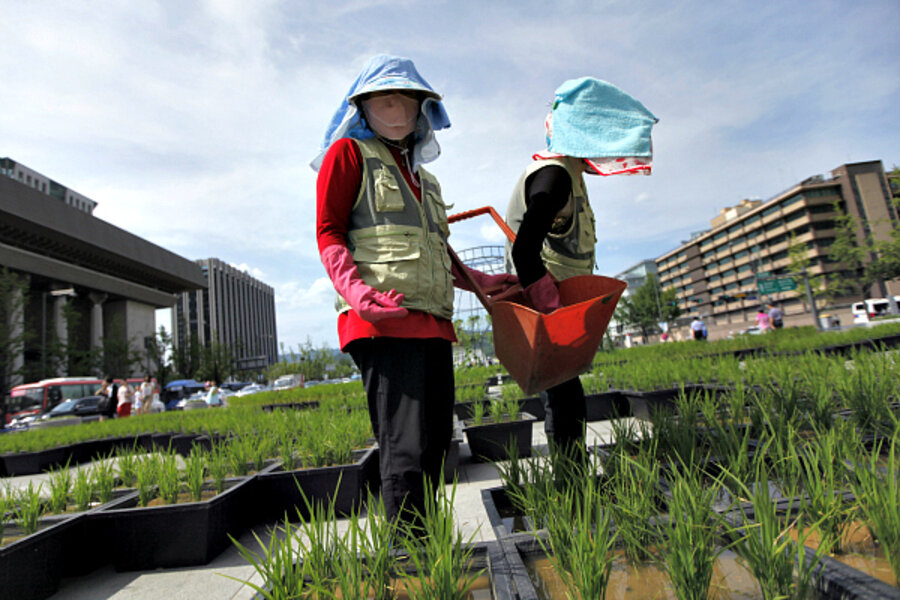Five cities and the groups that are making them green
Loading...
Currently more than half of the world’s 7 billion people live in urban areas, and according to the United Nations (UN) that number is expected to reach 65 percent by 2050. Dramatic population growth strains food resources and raises the challenge of feeding urban dwellers, particularly the poor. According to the UN, poverty is now growing faster in urban areas than in rural areas—there are currently 1 billion people living in urban slums.
Today, Nourishing the Planet highlights five cities and the organizations that are helping these cities become food-sufficient:
1. Dar es Salaam: More than 45 percent of Tanzania’s 2.3 million unemployed people live in the commercial capital, Dar es Salaam. Studies by the Tanzanian Department of Rural Development and Regional Planning have found that there is significant reduction in poverty among residents who practice urban gardening in Dar es Salaam. In 2011, 68 percent of residents are growing food and raising livestock in the city. According to the International Food Policy Research Institute, 90 percent of vegetables and 60 percent of the milk supply are produced locally.
Dar es Salaam in action: The Mikocheni Post Primary Vocational School is training students how to make a sustainable living and grow food in the city. The vocational school has become a learning center for waste separation, composting, and urban farming. The composting chambers are built by the masonry students, the cooking and carpentry students contribute organic waste to the compost, and all students take turns attending the gardens. The school also offers free training seminars on composting to the local community.
2. Detroit: The population of Detroit has shrunk by more than 50 percent since 1950 and the current population is just over 900,000. It is a city that has largely been abandoned by grocery stores and more than 550,000 residents live in food deserts, areas with limited access to affordable and nutritious food. But the city of Detroit, led by creative entrepreneurs, has the potential to rediscover its roots in urban farming.
Detroit in action: Detroit Black Community Food Security Network (DBCFSN) is a nonprofit working for food security and food justice. D-Town farm, DBCFSN’s seven-acre organic farm, is also a Regional Outreach Training Center for Growing Power Inc.
3. Cape Town: More than 30 percent of the 3.5 million inhabitants of Cape Town, South Africa, live below the poverty line. Philippi Horticulture Area in Cape Town is a large agricultural area that easily produces half of Cape Town’s fresh produce. Much of the 3,300-hectare area of farmland is left vacant by the owners and as a result hundreds of families have illegally settled the land.
Cape Town in action: Nazeer Ahmed Sonday has a small farm in the Philippi Horticulture Area. He is concerned both for the marginalized poor who are living there as well as the environment. Nazeer founded the Schaapkraal Developing Farmers Association, which in partnership with the Program in Urban Food Security at Cape Town University is helping struggling farmers. Nazeer hopes to protect the biodiversity of the area from developers, help farmers get access to markets, and help youths see agriculture as a respectable and desirable way to make a living.
4. St. Petersburg: Time is of the essence in St. Petersburg, Russia, where the growing season is only four months. Despite the harsh climate, more than 2.5 million of the city’s inhabitants are cultivating 560,000 hectares, an area roughly the size of Prince Edward Island, every year. Hardworking urban farmers produce an impressive amount of food annually, including 15,800 tons of potatoes; 47,400 tons of apples, pears, and plums; 38,500 tons of vegetables; 7,900 tons of strawberries; and 23 million cut flowers.
St. Petersburg in action: In 1993 the St. Petersburg Downtown Gardening Club established its first rooftop garden. In 1999, it began collecting kitchen scraps each week from the residents of the building for a vermiculture project (composting with worms). Every month they recycle over 500 kilograms of waste and every year they save 30,000 rubles (almost $1,000). The club has also started gardens at the city prison, therapy gardening at a prosthesis institute, and participated in school gardening projects across the city.
5. Havana: With the collapse of the Soviet Bloc in 1989 and the US embargo on fuel exports to Cuba, the country had a serious food shortage. But in Havana, residents became creative. The government formed the Urban Agriculture Department to secure land-use rights for urban gardeners as people began planting organic gardens in backyards, empty city lots, and balconies. Today, Havana is a world leader in urban agriculture, growing more than half of its produce within city limits.
Havana in action: The National Urban Agriculture Group (GNAU) has been important to the success of urban agriculture in Havana. Because of successful research and sustainable techniques, yield on urban farms jumped from 1.5 kilograms per square meter in 1994 to 25.8 kilograms per square meter in 2001. Especially productive units may receive various honors (“with excellence” is the highest honor and there are only 82 of these gardens in the country) giving farmers social as well as monetary incentive to be productive. These farmers also serve as facilitators when new technologies are developed, helping educate other people in the community. By giving prestige to urban farmers, effectively disseminating organic technology and information, the government of Cuba has done a great deal to help Havana feed itself.
• Jenny Beth Dyess is a research intern with Nourishing the Planet. To purchase "State of the World 2011: Innovations that Nourish the Planet" please click HERE.
• This article first appeared at Nourishing the Planet, a blog published by the Worldwatch Institute.
• Sign up to receive a weekly selection of practical and inspiring Change Agent articles by clicking here.





